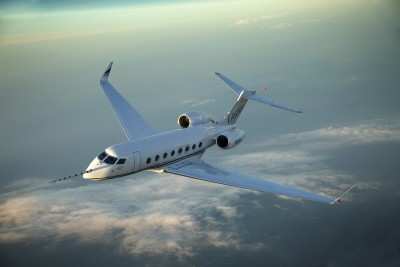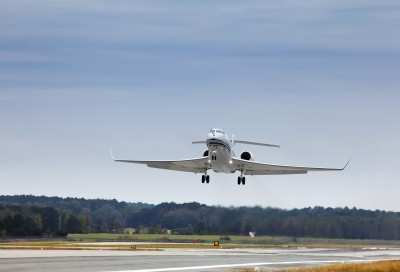Thu, Jan 13, 2011
Gulfstream Says First Flight Ever Using Electrically Powered
Flight-Control System
Gulfstream Aerospace Corp. test pilots and flight-test
engineers recently made business-aviation history when they flew
the Gulfstream G650 flight-test aircraft for the first time using
only an electrically powered, fly-by-wire backup flight-control
actuation system. Gulfstream's Serial Number (S/N) 6001 flew for a
total of 3 hours and 33 minutes on Dec. 21, 2010. Test pilots
Jake Howard and Gary Freeman along with flight-test engineers Bill
Osborne and Nathaniel Rutland evaluated the fly-by-wire system in
electric backup actuation mode for 2 hours and 20 minutes of the
flight, performing five landings with the backup system engaged.
"It flew so well that unless pilots were told they were in backup
actuation mode I don't think they would notice," said test pilot
Freeman.

File Photo
"The system performed flawlessly," said Pres Henne, senior vice
president, Programs, Engineering and Test, Gulfstream. "There was
no difference in handling qualities between the electrically and
hydraulically powered modes."
Typically, fly-by-wire uses a third hydraulic system to provide
redundancy in the event of a dual hydraulic system failure.
However, Gulfstream's fly-by-wire architecture uses electric backup
hydraulic actuators (EBHA): electrically controlled actuators that
are primarily hydraulically powered but offer electric power as a
backup. A self-contained hydraulic reservoir and motor pump allow
full operation should hydraulic loss occur.

The G650 has an EBHA at every primary control surface (elevator,
rudder and aileron) as well as the outboard spoiler. These provide
enhanced safety and aircraft availability because of the two
different power sources. The self-contained actuators also offer an
advantage following extremely rare failure scenarios, such as a
rotor burst.
The Dec. 21 G650 flight began with evaluating the electric
backup-mode handling qualities in one axis and then progressed to
full evaluations in all axes (pitch, roll and yaw). The test
conditions consisted of all flap settings at 10,000 feet for speeds
ranging from 1.13 reference stall speed (VSR) to maximum flap
extended speed (VFE). Cruise configurations were evaluated at
FL280, FL350 and FL450 and the full speed spectrum. The pilots also
initiated an emergency descent profile from FL450 to FL250.
Additionally, they evaluated handling qualities in the landing
configuration by making multiple offset approaches at Brunswick
Golden Isles Airport in Brunswick, Ga.
More News
Terminal Radar Service Area Airspace surrounding designated airports wherein ATC provides radar vectoring, sequencing, and separation on a full-time basis for all IFR and participa>[...]
Very High Frequency (VHF) The frequency band between 30 and 300 MHz. Portions of this band, 108 to 118 MHz, are used for certain NAVAIDs; 118 to 136 MHz are used for civil air/grou>[...]
“From approximately November 2021 through January 2022, Britton-Harr, acting on behalf of AeroVanti, entered into lease-purchase agreements for five Piaggio-manufactured airc>[...]
Also: Virtual FLRAA Prototype, IFR-Capable Autonomous A/C, NS-32 Crew, Golden Dome Missile Defense Bombardier announced that the first production Global 8000 successfully completed>[...]
Aero Linx: The 1-26 Association (Schweizer) The Association’s goal is to foster the helpfulness, the camaraderie, and the opportunity for head-to-head competition that is fou>[...]
 ANN's Daily Aero-Term (05.29.25): Terminal Radar Service Area
ANN's Daily Aero-Term (05.29.25): Terminal Radar Service Area ANN's Daily Aero-Term (05.30.25): Very High Frequency (VHF)
ANN's Daily Aero-Term (05.30.25): Very High Frequency (VHF) Aero-News: Quote of the Day (05.30.25)
Aero-News: Quote of the Day (05.30.25) Airborne 05.23.25: Global 8000, Qatar B747 Accepted, Aviation Merit Badge
Airborne 05.23.25: Global 8000, Qatar B747 Accepted, Aviation Merit Badge ANN's Daily Aero-Linx (05.30.25)
ANN's Daily Aero-Linx (05.30.25)




